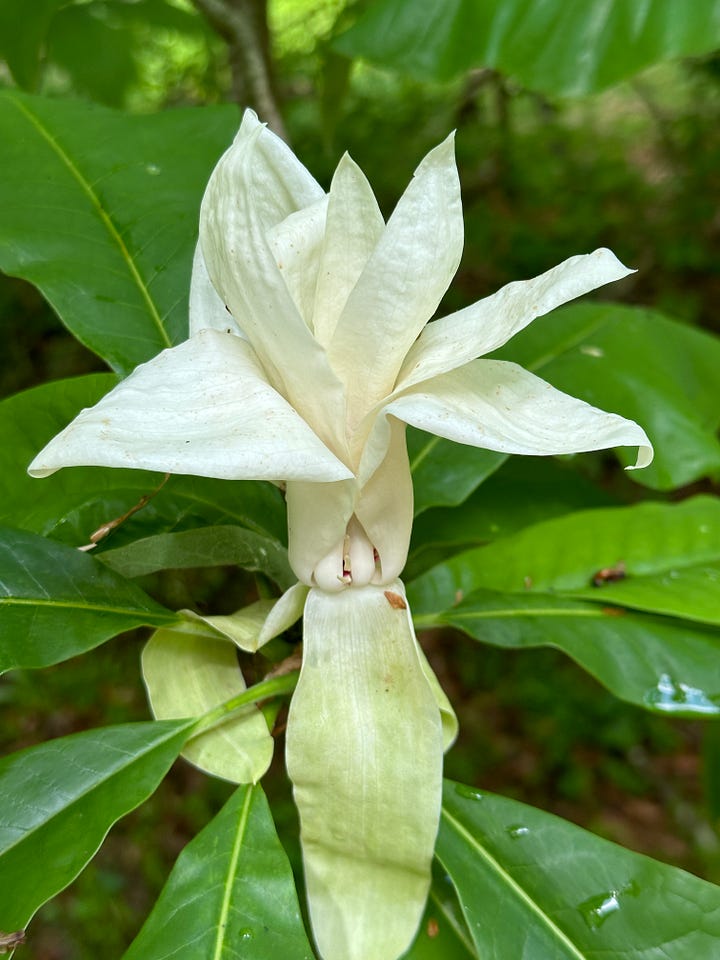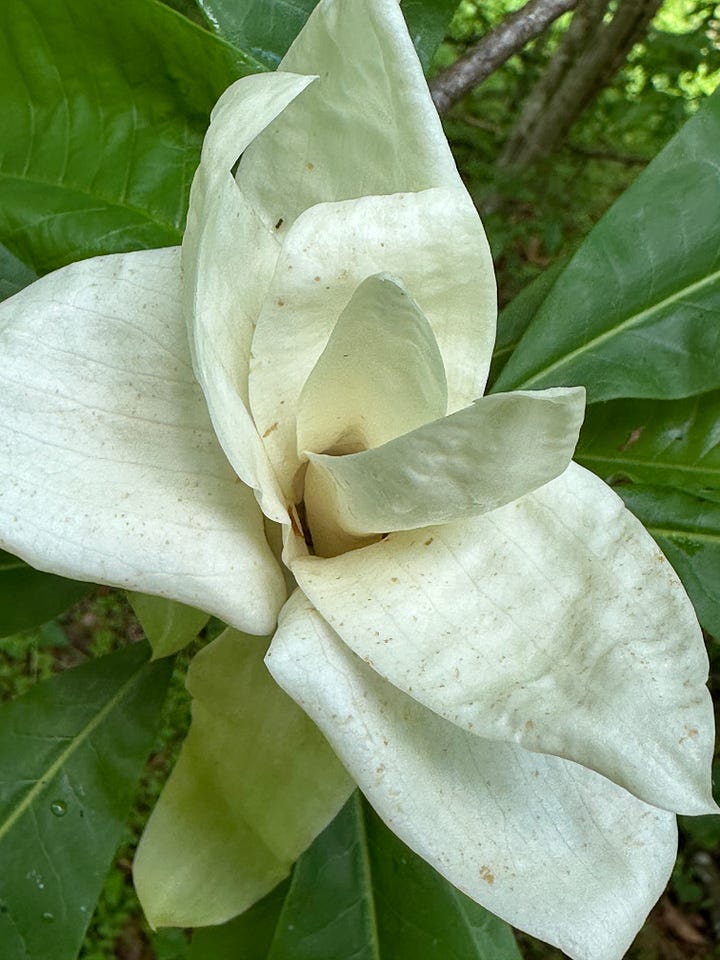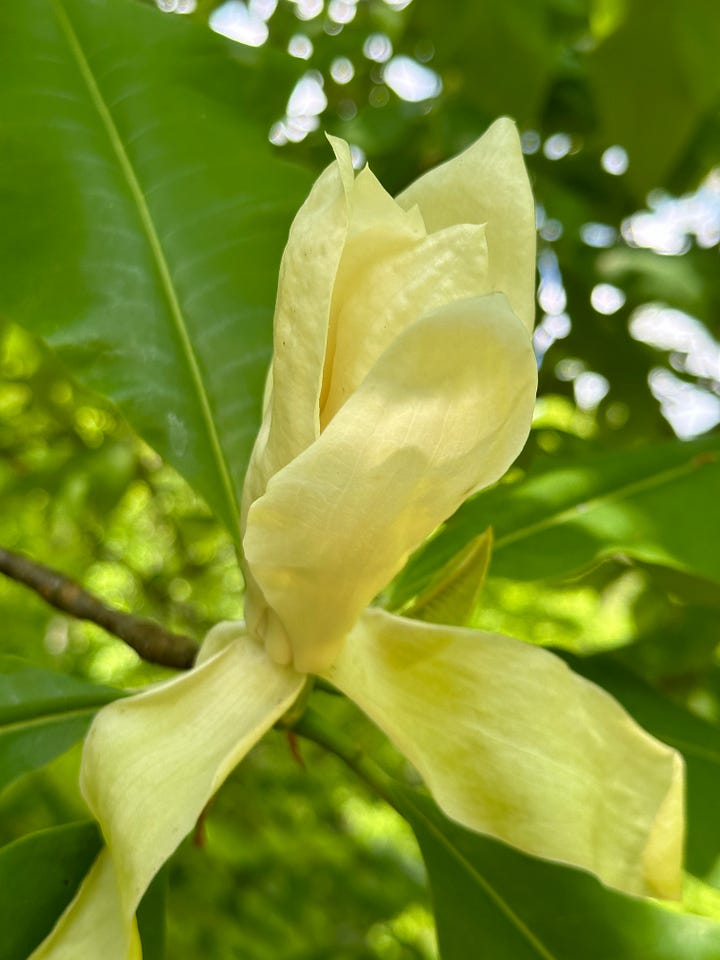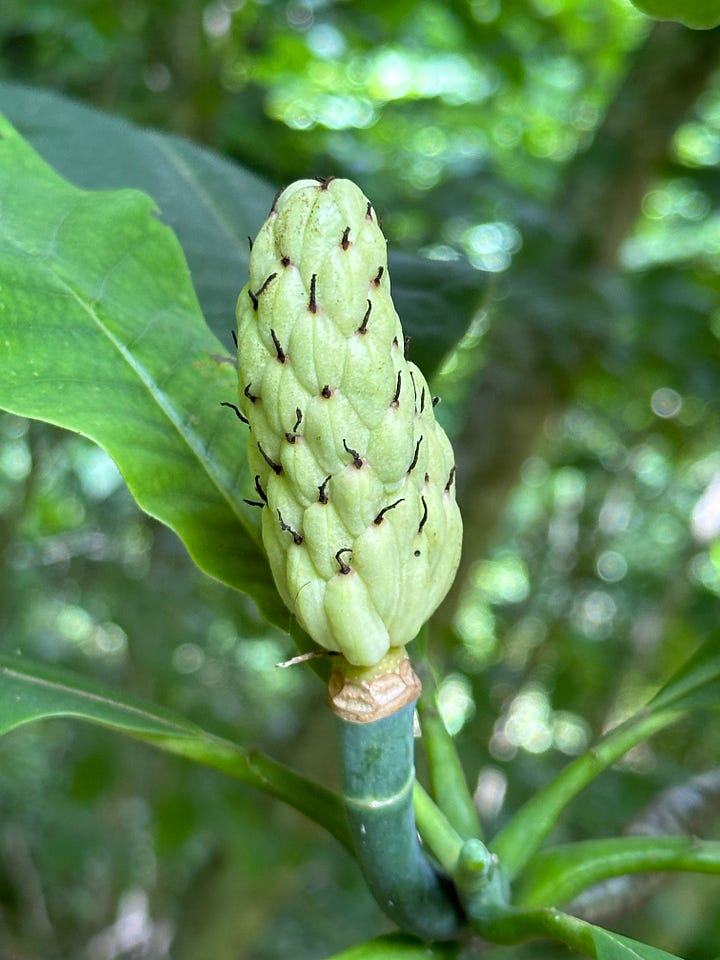I have often written about the ancient magnolias that have graced much of my life. With ancestry over one hundred million years old, these ancient great-grandflowers are older than the bees. They courted beetles instead as their first lovers and pollinators. They are the oldest flower that still resembles their descendants living today.
In my upcoming book, The Flowers Are Speaking, I write about the southern magnolia—Magnolia grandiflora—that is native to the southeast United States and well-known and beloved by most everyone who lives in this region of the world. They grow naturally in their native forests in the far south, but I have never seen them growing wild in an undisturbed forest myself. Fortunately, they are also widely cultivated and willingly live in our human landscapes. For most of my life, my homes have been graced with a southern magnolia next to me or nearby.
Each May, the huge flowers of this shiny-leaved tree simply undo me. These words from my upcoming book try to capture my experience:
“While the beauty of the magnolia flower alone is enough to make me speechless, their luscious, deeply fragrant scent completely overrides my rational thought and sends me reveling deep into my animal body. Delicately rose sweet, yet with the fresh clarity of citrus—it is the quintessential scent of late spring romance for me. I want to crawl into their flower, curl up and stay there, wrapped in their strong soft petals with their scent intimately washing over me, stroking my naked skin. As magnolia’s scent wafts under my nose, they open an ancient doorway that shifts time, and a brief glimpse flashes through my mind’s eye of the long procession of all those magnolias who have come before, one magnolia mother after another.”
These magnolia flowers and I have developed a deep devotion for each other, finding ways to bridge the gap between our vastly different species—a closeness that only comes with beings I live alongside and interact with most days. This devotion spills over from the magnolia trees in my yard to other southern magnolias I come across everywhere. I feel that once I have come to intimately know one of them, it is as if I have learned their language and can converse with all their relations.


Years ago, I learned a local tree that I always knew as an umbrella tree was part of the Magnolia family. Growing in the Appalachian forests of West Virginia where I love to hike, this wild tree has huge oval leaves up to twenty-four inches long that radiate out from a single point on each branch, like an umbrella. But I had never seen them flower. They are often just small understory trees that get very little light, and they are deciduous, losing their leaves each fall. Their leaves are not shiny and tough like their cousins, but rather like the texture of other tree leaves in our forests here. I always wondered what their blooms were like. But because only the older mature trees bloom, with their blooms high up in the canopy, I have missed them or been unable to see them closely.
I had a nudge to visit a new trail this spring, one that began along the edge of large meadow, where for the first time I saw several large wild umbrella magnolias that were in full bloom. As the awe of them descended over me, I squealed in delight. These trees are not as showy as their cousins, but they were regal, nonetheless. Easily fifty feet tall, most of the blooms were much higher than I could reach. But the open meadow allowed a few lower limbs to bow down towards the ground offering me the grace of their flowers. I could just reach them and pull them to my nose.
These wild magnolias generate wonder and awe in my heart differently than the stately southern magnolias—something about their wildness, how they have grown as part of this woodland community all their lives. Their blooms are almost as large as the southern magnolia, but their petals are softer and a bit skinnier. Taking in their fragrance, their scent was much more subtle than their southern cousins. Still a bit citrusy, but the sweetness is mostly gone and replaced by a woodsier, slightly dank smell. Reading about this species, their smell is described as unpleasant, but I disagree. These writers must not be able to let go of a comparison to the southern magnolia. To me, the umbrella magnolia blossom smells like the forest community they are part of, from the mossy, rotting trees feeding their roots.




I am endlessly grateful to begin to deeply know this wild cousin of the magnolias I live with. How much deeper is their understanding of home when they have been born and lived all their lives alongside thousands of generations of their ancestors in the same ecosystem? I am in awe of their dedication to these ancient Appalachia hills, clinging to them through untold changes and upheavals. And blossoming—opening their huge flowers over untold eons—carrying their stories into the next generation, one after another.
I am fascinated by their wildness, perhaps because I have lost most of my own. I am used to my comforts, addicted to civilization, unable to live without them. Yet I often think about what it would have been like to live centuries ago, or even eons ago, when my individual self would not have been nearly as important as my kin, my ecosystem, the balance of all life all around me. To be wild is to eat and be eaten, feeding each other, sustaining each other, taking turns for abundance, for decay, for new life. Always generating new life.
These two magnolias, the wild forest umbrella magnolia, and the cultivated southern magnolia, sustain both parts of me—the longing for my wild roots and the sanctuary of my civilized home among my community of fellow humans. I need both. I need to know I can be wild without having to give up my community. Longing for the wild forest and embracing my wild edges feeds me, helps me be attuned to all other life around me, a skill we all need to find new ways to rebalance our lives on this planet we all call home.
We need the wildness of the world, and we need to reclaim wildness in ourselves. We need all our feral, unfettered senses to be able to hear, feel, see, smell, and taste our way home. We need to be just wild enough to allow our heart’s desires to thrive, to imagine new ways of living in a changing world. When I allow the ancient wisdom of both the wild umbrella magnolia, and the more cultivated southern magnolia, to each feed my body and soul, I feel more at peace, more alive, more balanced, than when I strive to be only feral or only safe. I thrive, having them both in my life.




" I feel more at peace, more alive, more balanced, than when I strive to be only feral or only safe. I thrive, having them both in my life"--yes! Reminds me of the Strength card in the Tarot,
I just came back from the south, where I fell in love with the southern magnolia, a tree I'd never seen before. There were so many in the neighborhood where I stayed, and they called me. The glossy leaves, the citrus scent of a grand flower that beckoned me from where my brother and I were strolling along a busy road--it was as though I fell into the flower and into another realm altogether. The tree had an entirely different energy than the local wild Catskill magnolias, trees I also love. Thank you for your post on wildness and comfort.